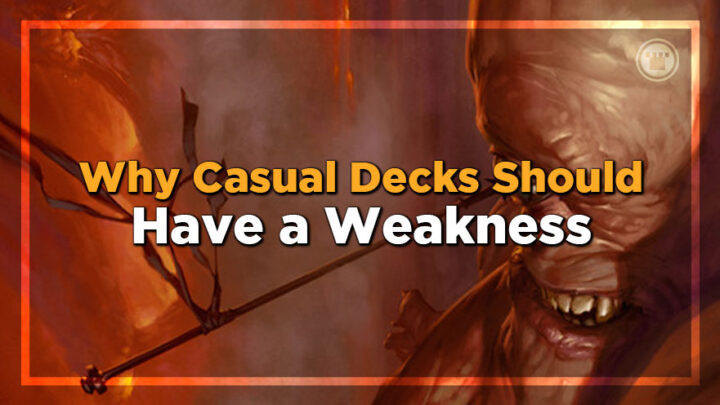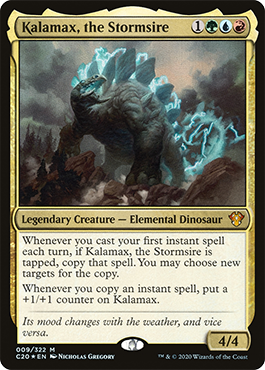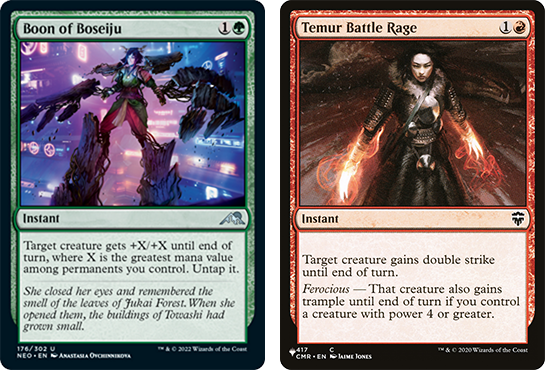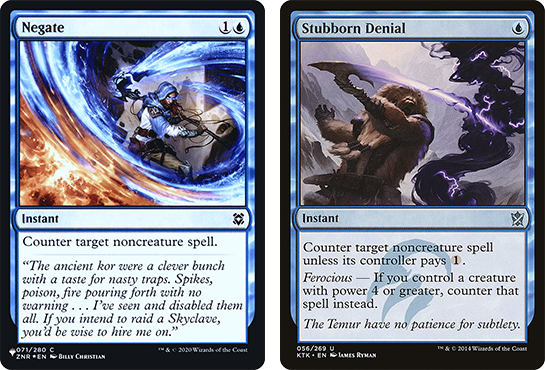Sometimes, perfection can be boring. Scott talks about how building a weakness into your casual EDH deck can be more fun!
Deck building can be a difficult skill to master, especially when you’re building for casual Commander. Finding the right amount of synergy and power to suit the games you want to play can be tough; power levels are extremely nuanced (hence the need for pregame conversations), and can be misinterpreted easily. Even more seasoned deck builders can struggle with this, which is a testament to the complexity of balancing a deck.
I’ll use a recent personal deck as an example. I decided to brew up a new Spellslinger deck, so I built one with Kalamax, the Stormsire as the commander. I wanted it to have some decent card draw and interaction, and rely on the creatures to generate enough value to outlast and overwhelm my opponents.
I tested it with my regular playgroup a few days ago, and the games didn’t go quite how I wanted them to. The deck was too good. It wasn’t that it was running more powerful cards than everyone else, or that it was too fast for the table, or even that it won (it didn’t). The problem was that there was no real weakness. That sounds like a good thing, but not so much when you’re playing casually. I’m going to attempt to explain why.
First of all, if a deck is devoid of any weakness, then you’re not really extending an appropriate level of trust to the table. Assuming that you’re there to have fun first and foremost, a weakness isn’t a negative thing; it’s more of a display that your intentions are true. You’re not there to win, so the deck isn’t optimized, meaning there’s likely some sort of weak point.
Secondly, if we’re all playing to have fun, then it’s pretty normal to let everyone do their thing at least a little bit. Sometimes a deck can start to run away with a game too soon, and it can lead to a boring or negative experience for others. A weakness is like a safety valve, something that others can interact with to take you down a peg. It needn’t be an Achilles heel, but there needs to be a crack in the armor so that others can stop you if things get out of hand.
Perhaps the most compelling reason for having a weakness in your casual decks, is to invite dramatic tension to your games. As I mentioned in last week’s article, recognizing and assuming your role in any given game can lead to the wildest and most memorable experiences. If you’re the underdog, people will remember when you come back from the brink of death. Similarly, if you become the villain, it’s down to the table to band together and save the day. Weakness allows you to embody these roles far more convincingly than a deck with a watertight strategy ever will. This is why almost all good villains have weaknesses. If they had none, they’d probably just defeat the heroes and extinguish all hope. Good stories give you that glimmer of hope, that one-in-a-million chance to pull a victory out of the bag. This was the problem with my Kalamax deck: it didn’t really give other players the opportunity to have hope.
It was great at protecting its game plan, drawing cards, interacting, and pressuring, all at the same time. While this would be fine for higher power games where that level of interaction and threat is to be expected, it’s not suitable for the more casual end of the spectrum, which is where I wanted this deck to reside.
In a strange way, having no weakness was a kind of weakness in itself. Kalamax is a powerful commander already, and building a consistent deck around them only amplifies their strength. This was evident when I asked my playgroup for feedback after the games: they told me in that deck, Kalamax was a “kill on sight” commander. After seeing them try and fail repeatedly to slow me down, I have to agree. That kind of performance can lead to the deck being targeted more than usual, which can warp the perception of the deck into feeling less fun. I know I would end up playing it less and less as time goes on, due to being associated with negative or boring play experiences.
Is this a sign of bad deck building? Not at all, provided this isn’t where the deck’s journey ends. Being a good brewer and deck builder is about more than just knowing the cards, it’s also about how to apply them to get the desired result. Deck building is only ever bad if you learn nothing from the process, and you decide to ignore the signs that something should be changed.
- “Is this deck doing what I wanted it to do?”
- “Does this fit the vision or role I had for the deck originally?”
- “Will I actually play this deck and enjoy it?”
These are the questions I asked myself after playing with Kalamax, and they’re the kind of questions you should ask yourself during the building and testing process. It can be all too easy to build a deck that looks fun to play, but in practice it might not feel right. It’s important to be able to recognize when this happens, even all the way back in the deck building stage.
So how do you fix this? Unfortunately there’s no “one size fits all” answer to solving these kinds of issues, though there is a lot you can try in your search for the right deck.
Change Things Around
Most of the time, trial and error will prove invaluable; this can be anything from swapping out a few cards, to completely changing the theme of the deck. Testing is the key to this, as you don’t know how a deck will perform until you’ve given it a proper game.
In the case of Kalamax, I decided to change its focus into a more niche build. It became a deck that makes the most of combat tricks and pump spells, but I had to pull out the “good cards” like Dig Through Time and Counterspell to make room for them. While this bolsters its overall ability to pressure opponents, it also relies on that pressure much more just to function effectively. It can now be stopped dead in its tracks with a timely board wipe, or completely blown out with a fog effect. It can still run away with a game, but it’s much more healthy; it encourages interaction rather than forcing it.
The Staples Problem
Staples are staples for a reason: they’re often the best at what they do. I mentioned in my Commander New Years Resolutions article that removing staples from decks can be an excellent way to encourage creativity and allow for interesting gameplay. Including these staples can also contribute to a deck’s perceived lack of weakness, as your cards are always going to be effective. Replacing those universally powerful pieces with more situational or synergistic cards can give your decks a more balanced feel.
The cards you use to replace the staples don’t even have to be weaker cards, but rather have a higher risk/reward. A good example of this is Negate, which was in my original Kalamax build. I’ve replaced it with Stubborn Denial; while this doesn’t seem like much of a change, there are different moments where it’s better or worse than the original card. Denial’s risk is that it’s worse than Force Spike and it requires me to have a creature with power 4 or greater on board to have the same effect, but the reward for this is that it costs half as much to cast. This kind of balancing can manage a deck’s capabilities without losing any of the feeling of power within.
Beware the Average Deck
EDHREC is one of the best and most comprehensive tools on the internet for Commander deck building. It has near endless data on the format, and you can make a solid base from which to build your next deck within minutes. I would strongly recommend it to any brewer, as it’s one of the most comprehensive and popular tools of the trade. As with all tools though, responsible use is crucial for it to be effective.
Perhaps the quickest way to build a deck using EDHREC, is to look at the “Average Deck” section. This gives you an aggregate of all of the decks in the database for the commander in question, giving you a very rough idea of what a typical deck would look like. This base deck model is great to start from, and can often produce pretty decent decks by itself. The concern I have with this approach is that you don’t get an indication of power level; considering Commander has been gradually increasing in speed and efficiency over the past couple of years, this will reflect in the data and deck lists. The average deck for a commander today is likely to be more powerful than the average deck for the same commander two years ago. Keep this in mind if you use the Average Deck feature to get the ball rolling on a new brew, as you may need to tune it down slightly to suit the games you’re looking to play.
Here is my new Kalamax, the Stormsire deck. It has changed quite a bit; while it now relies on creatures to function effectively, it’s a much healthier casual deck overall. It commits more to the board, it rewards the pilot for engaging in combat, and it encourages interaction. I can still pull off some incredible turns and win games in spectacular fashion, but I’m allowing others to take the spotlight when it’s their turn.
I hope this has helped you in some way, either to look at casual decks in a different way, or to continuously reevaluate your priorities when building and brewing. I’ve certainly learned that in casual Commander, maximum fun is achieved only when everyone is experiencing it equally; building my decks to allow others the opportunity to enjoy the game is something I’ll be employing going forward.
Is there anything you do during deck building to maximize the enjoyment of the table? Do you build in a weakness to help regulate power levels? Are there any other considerations or changes during deck building that you’ve found to be beneficial? Pop me a message over on Twitter, I always love hearing about other brewers’ processes and designs! Happy brewing!

Scott is an Irish content creator and the Head of Budget Magic for the Izzet League. He focuses on affordable decks in Pioneer, Modern, and Pauper, particularly ones that stray from the mainstream. When he’s not writing about his favorite decks, he can be found talking incessantly about them on Twitter and on The Budget Magic Cast.




